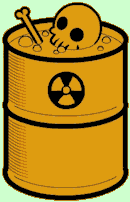Harmful Chemicals
|

|
Harmful chemicals damage the body in one of these three ways:
- Damage the cells directly
- Interfere with one or more of the body’s complex chemical processes that keep the body going.
- Adversely affect the body’s filters which help to cleanse the body’s. These filters include the liver, kidneys, lungs and lymph.
|
Only a few people are affected by acute exposure to chemicals. Rather than acute exposure, the most common type of exposure to harmful chemicals is chronic exposure (little by little) until enough chemical has accumulated to affect one’s health. Our bodies begin accumulating harmful chemicals even from before birth.
Overtime, chronic exposure to harmful chemicals can result in:
- autoimmune disorders
- central nervous system disorders (Parkinson’s, Alzheimer’s)
- heart disease
- cancer
- difficulty thinking
- panic attacks
- sensitivity to light
- skin rashes
- chronic fatigue
- and much more
Common harmful chemicals include the following (you may be surprised to see items that you think of as harmless):
- Insecticides, rodenticides, fungicides, herbicides, repellents. These work by damaging the cells of the target animal or plant... and humans.
- Nitrogen in compounds such as petrochemical fertilizers affects communication to cells so they open up and take in other toxins.
- Halogenated hydrocarbons, like chloroform, which are liver and kidney toxins.
- Alcohols and glycols such as antifreeze, brake fluid can kill pets who are attracted to it. These compounds dissolve the fatty nerve sheaths, thereby stimulating and then depressing the central nervous system.
- Aldehydes, ketones and ethers, which are all types of chemical compounds found in wall paneling and cleaning products.
- Paints and solvents damage the central nervous system penetrating the fatty myelin nerve sheath.
|
- Drugs
- Soaps, detergents, sanitizing agnets, hair dyes and deodorants are often formulated to dissolve oil and can also break down our own lipid (fat) containing cell walls.
- Cologne, soaps, toilet articles.
- Glues
- Halides or halogens such as chlorine, fluorine, bromine and iodine. Some of these are added to our drinking water, although many are now outlawed in Europe due to their toxicity.
- Inhaled fibers such as asbestos and silica, which are sharp and will puncture cell walls in our lungs.
- Aromatic hydrocarbons such as benzene and toluene which dissolve cell membranes and nerve sheaths and can cause extensive damage to the central nervous system.
|
|
|
|
How do chemicals get into the body?
The three major routes are:
- Inhalation into the lungs
- Ingestion into the stomach
- Topical through the skin
In order to be toxic, a chemical usually must travel into the body. That means it must be water or fat soluble. Otherwise, it would be excreted without having done damage. An exception occurs when a person has leaky gut and what would normally not enter the body is able to get into the blood stream.
|

